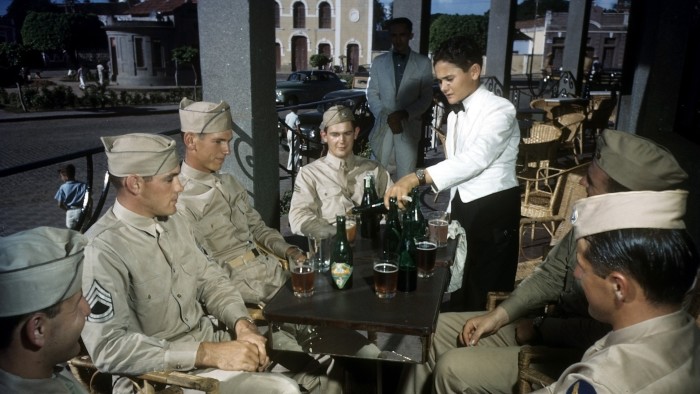During his first three months in power, Donald Trump announced an extension of the wall on the Mexican border, made Cuba on the list of “state sponsors” and threatened to annex the Panama canal.
Trump's often hard position on Latin America follows centuries of intertwined policy, turbulent and collaborative. Indeed, as evidenced by a leading historian of the Western hemisphere, the history of the United States – in particular of independence to the Second World War – is closely linked to countries to its south.
America, America focuses on these vital connections. Greg Grandin's argument – the first time it was made in depth and for a non -specialist audience – is convincing and written with a zest. Grandin is a professor of Yale winner of the Pulitzer Prize whose previous work has explored the American border, Henry Kissinger and the Ford Plantation-City in the Amazon. Here, he focuses on less known stories of American relationships in America.
Such a forgotten fact is that the Spanish colonies in the Americas were crucial for the outcome of the American revolutionary war. Spain has provided help and up-to-date weapons to the besieged army of George Washington, and fought Great Britain in the Caribbean and as far north as Lake Michigan. The support of Spain, Grandin, reminds us, relied on the infrastructure of its colonies, its mineral wealth, its planting economy and its public good will (fund for the decisive battle of Yorktown, for example, were collected in Havana).
In 1823, after the independence of most of Spanish America, the American president James Monroe warned the European powers not to intervene in the Western hemisphere. The monroe doctrine, ambitious and ambiguous, was initially welcomed by the fragile republics, which feared the reconquest. What MONROE doctrine did not do, however, was to avoid interference from the United States. In the mid-1820s, while southern slavers sought more land, the United States already explored the capture of Mexico Texas. After the American-Mexican war of 1846-1848, she had captured more than half of her neighbor's territory.
Much of the American-Latin relationship in America, however, was fraternal. As Grandine does not problem, she was particularly cordial under the Democrats Woodrow Wilson (1913-21) and Franklin D Roosevelt (1933-45). Wilson compensated Colombia by $ 25 million for the separation of Panama, arranged by the United States, in 1903, and took the tradition of the Americas of international collaboration as its plan for Europe after the First World War.
Grandin explains that the administration of Roosevelt, probably the most important in American history, owed a major debt to Latin American ideas. In 1933, two months after its mandate, and with the country still stuck in the great depression, negotiations across the hemisphere in Montevideo led (against the wishes of many American industrialists) to the reduction of prices. In addition to the devalued dollar, these American exports started and, in the words of Grandin, helped “save the New Deal”. Roosevelt himself said so much during a visit to Rio in 1936: “These are two people who invented the New Deal. The president of Brazil (Getúlio Vargas) and the President of the United States. ”
Roosevelt's good relationship with the rest of the hemisphere was critical during the Second World War. The allies in Central America allowed us the ships to see without translated access to the Panama Canal, which linked the countryside of the Pacific and the Atlantic. Roosevelt called the Brazilian native air base, which leads in the middle of the Atlantic, the “trampoline to victory”.
Then there were critical supply chains – including essence, copper, platinum, tin and rubber. “No one knows,” recalls an American army official, “how much we have relied on the countries of South America and Central America for basic products and the things that we simply have to have.” In his treatment of post-war years, Grandin discovers convincing and little known declarations made by the main figures of the time. For example, John Foster Dulles, Secretary of State of Dwight Eisenhower, said that without Latin America, “there would have been NO NATO.” Winston Churchill went further: “There would have been nothing.”
In return, the Latin American nations, whose economies depended too much on the natural resources that had supported the war effort, asked President Harry Truman to industrialization subsidies similar to the Marshall Plan. They did not get them.
The refusal of the United States was part of its general change in priorities. With the exception of trying to contain communism (real or imagined), the United States began to think less of the Western hemisphere, and more on the world as a whole. “The region has become out of the mind,” writes Grandin. “What counted was a renewed alliance of Washington-London, emphasizing a rebuilt Western Europe and now that Mao was in Beijing, a Asia focused on Japan.”
This position on Latin America is roughly where we are today. The region remains full of American interests, but is generally neglected, except when politicians want to contest immigration, calling on antisocialist diasporas or complaining about its neighbors with China.
Grandin provides the context for all of this, and much more. Its history is impactful and, although partially informed by a left -wing commitment, generally remains within the limits of objectivity. The range of sources is large, and despite the length of the book, the narrative rhythm is superb.
America, America is an agonizing attraction for American American American relations mutually beneficial. The United States, as a dominant power, must take the lead – as it did under Wilson and Roosevelt. Grandin makes a powerful argument in favor. Do not be surprised if he wins another pulitzer.
America, America: a new story of the new world by Greg Grandin Torva £ 30 / Penguin Press $ 35, 768 pages


